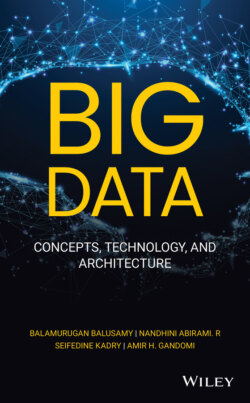Читать книгу Big Data - Seifedine Kadry - Страница 27
1.8 Big Data Life Cycle
ОглавлениеBig data yields big benefits, starting from innovative business ideas to unconventional ways to treat diseases, overcoming the challenges. The challenges arise because so much of the data is collected by the technology today. Big data technologies are capable of capturing and analyzing them effectively. Big data infrastructure involves new computing models with the capability to process both distributed and parallel computations with highly scalable storage and performance. Some of the big data components include Hadoop (framework), HDFS (storage), and MapReduce (processing).
Figure 1.10 illustrates the big data life cycle. Data arriving at high velocity from multiple sources with different data formats are captured. The captured data is stored in a storage platform such as HDFS and NoSQL and then preprocessed to make the data suitable for analysis. The preprocessed data stored in the storage platform is then passed to the analytics layer, where the data is processed using big data tools such as MapReduce and YARN and analysis is performed on the processed data to uncover hidden knowledge from it. Analytics and machine learning are important concepts in the life cycle of big data. Text analytics is a type of analysis performed on unstructured textual data. With the growth of social media and e‐mail transactions, the importance of text analytics has surged up. Predictive analysis on consumer behavior and consumer interest analysis are all performed on the text data extracted from various online sources such as social media, online retailing websites, and much more. Machine learning has made text analytics possible. The analyzed data is visually represented by visualization tools such as Tableau to make it easily understandable by the end user to make decisions.
